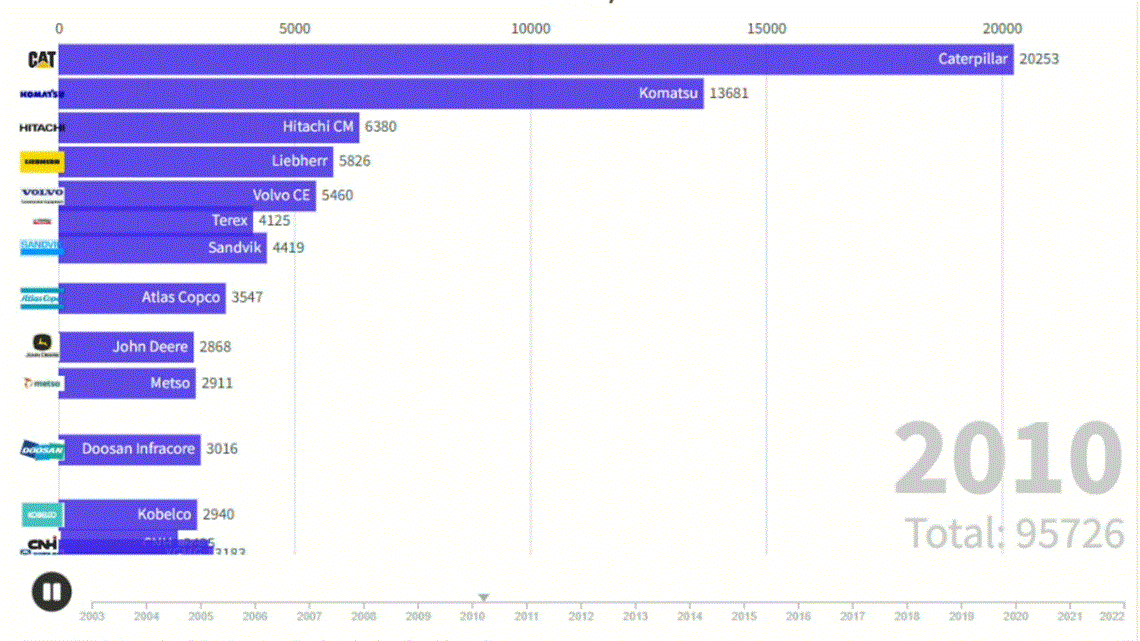How the hierarchy of the top construction OEMs has changed over 20 years
09 March 2023
A new animated chart shows the dramatic change in the hierarchy of the biggest construction equipment manufacturers over 20 years.
The chart draws on data from International Construction’s Yellow Table, which tracks the top 50 construction OEMs across the world. For viewing clarity, this animation follows the top 15.
Data from the Yellow Table stretches back to 2003, up until the latest version in 2022.
While Caterpillar has remained top of the tree throughout that time, other manufacturers have risen steadily through the table. They include Chinese companies XCMG and Sany, neither of which was in the top 15 when the Yellow Table started in 2003. They now occupy third and fourth spots respectively, according to the 2022 data. They are joined by Zoomlion and Liugong, which means that four of the top 15 manufacturers now hail from China.
The context behind the changes
Most companies who were big suppliers of construction equipment 10 or 20 years ago are still big suppliers now. But that doesn’t mean that the names right at the top of the list are still there now, says Chris Sleight, managing director of Off-Highway Research.
“There has obviously been some consolidation in the industry and it is those big companies that have mainly done the consolidating,” he says.
“And in one or two cases, companies have got their strategy wrong and the highly placed ones 20 years ago would be less highly placed now. There has been consolidation among the traditional suppliers and the big companies today are also the big companies of yesterday.”
Meanwhile, up to half a dozen big Chinese OEMs have imposed themselves among the top companies.
“What is striking is how far they have risen up the table and how much they are vying in revenue terms with those traditional suppliers,” says Sleight.
“The Chinese market has its ups and downs but for most of those Chinese OEMs derive 70-80% of their revenues from their home market alone. Having said that, over the years they have exported more and more. They have pushed out into other emerging markets in particular.”
The covid pandemic has also aided the growth of the Chinese OEMs. “Those that had a bit of a beachhead in Europe have grown quite nicely, mostly because they could supply machines where other people were having lead time problems and component shortages,” Sleight asserts.
The Yellow Table
To view the 2022 version of the Yellow Table in full, click here. You can also find an archive of the Yellow Table stretching back to 2006 online in International Construction’s digital editions.
Positions in the Yellow Table for each year are construction equipment sales based on sales in the previous calendar year in US dollars. Currencies have been converted to dollars based on the average exchange rate over the course of each year to try and ensure fairness.
Each year, International Construction gathers data from a variety of sources, including audited accounts, company statements and reputable third party sources. In Japan, India and certain other countries, the use of the fiscal year (end of 31 March) makes it impossible to establish calendar year information. In these cases, fiscal year results were used.
In some cases, International Construction made an estimate of revenues based on historical data and industry trends. While every effort has been made to ensure information in this chart is accurate, International Construction does not accept any liability for errors or omissions.
If you would like to comment on the Yellow Table or feel your company should be included, please email International Construction editor Andy Brown at: [email protected]
STAY CONNECTED



Receive the information you need when you need it through our world-leading magazines, newsletters and daily briefings.
CONNECT WITH THE TEAM









